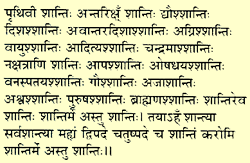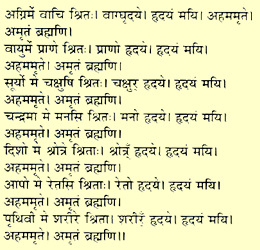|
To: |
 |
To: |
![]()
![]()
![]()

As learnt at
the Lotus Feet of Bhagavan
by
N. Kasturi (1897-1987)
![]()
![]()
![]()
![]()
![]()
![]()
Concerning:
Vedic
Chanting; Taittirîya
Aranyaka
[see also the mentioning of the
Taittirîya-samhitâ ('the partridge
collection') in S.B.
12.6:64-65] Taittirîya
Aranyaka, 4th Prasna (Pravargya Mantras, 42nd
Anuvaka) Prthivee
Shaantih Antarikshan Shaantih Translation: Summary: Taittirîya
Brahmana, 3rd Ashtaka, 10th Prapatha ka, 8th
Anuvaka Agnirme
Vaachi Shritah. Vaagghrdaye. Translation: Summary: Sri
Sathya Sai Veda Pratishtan:
The
portal (website) vedamu.org
is primarily designed to give Vedic literature in its
entirety as available in India. Jyoti
meditation
-
Silent sitting. Hatha
Yoga:
(sun-moon): the yoga of the bodily strength.
TO PATHWAY TO PEACE - Part
I
- Part
II
- Part
III
- Part
IV
|
purports
1
| purports
2
| purports
3
| purports
4
|


Dyaushshaantih Dishashshaantih
Avaantaradishaashshaantih Agnishshaantih
Vaayushshaantih Aadityashshaantih
Vhandramaashshaantih Nakshatraani
Shaantih Aapashshaantih
Oshadhayashshaantih
Vanaspatayashshaantih Gaushshaantih Ajaa
Shaantih Ashvashshaantih Purushashshaantih
Brahma Shaantih Braahmanashshaantih
Shaantireva Shaantih Shaantirme Astu
Shaantih. Tayaaham Shaantyaa
Sarvashaantyaa Mahyam Dvipade
Chatushpade Cha Shaantim Karomi
Shaantirme Astu Shaantih
"May
there be peace on earth, peace in the
ether, peace in the heaven, peace in all
directions, peace in fire, peace in the air, peace
in the sun, peace in the moon, peace in the
constellations, peace in the waters,
peace in the plants and herbs, peace in trees,
peace towards cattle, peace towards goats,
peace towards horses, peace towards
mankind, peace in the absolute Brahman,
peace in those who have attained Brahman,
may there be peace, only peace.
May that peace be in me, peace alone.
Through that peace may I confirm peace
in myself, and all bipeds and quadrupeds.
May there be peace in me, peace alone."
This
is the central portion of the famous Mahashanti Mantra,
the great prayer for peace. As well as being the final
anuvaka of the Pravargya mantras, it is also the Shanti
mantra of the 5th Prasna of the Taittiriya Aranyaka which
is the Brahmana for Pravargya
Hrdayam Mayi. Ahamamrte.
Amrtam Brahmani.
Vayurme Praane Shritah. Praano Hrdaye.
Hrdayam Mayi. Ahamamrte.
Amrtam Brahmani.
Suryo Me Chakshushi Shritah.
Chakshur Hrdaye. Hrdayam Mayi.
Ahamamrte. Amrtam Brahmani.
Chandramaa Me manasi Shritah.
Mano Hrdaye. Hrdayam Mayi.
Ahamamrte. Amrtam Brahmani.
Disho Me Shrotre Shritaah.
Shrotragum Hrdaye. Hrdayam Mayi.
Ahamamrte. Amrtam Brahmani.
Aapo Me Retasi Shritaah. Reto Hrdaye.
Hrdayam Mayi. Ahamamrte.
Amrtam Brahmani.
Prthivee Me Shareere Sritaa.
Shareeragum Hrdaye. Hrdayam Mayi.
Ahamamrte. Amrtam Brahmani.
"Air is established in my breath.
My breath is my heart. My heart in me.
Myself in the immortal, the immortal in Brahman.
The sun is established in my eyes.
My eyes in my heart. My heart in me.
Myself in the immortal, the immortal in Brahman.
The moon is established in my mind.
My mind in my heart. My heart in me.
Myself in the immortal, the immortal in Brahman.
The direction is established in my ears.
My ears in my heart. My heart in me.
Myself in the immortal, the immortal in Brahman.
The waters are established in the seed.
The seed in my heart. My heart in me.
Myself in the immortal, the immortal in Brahman.
The earth is established in my body.
The body in my heart. My heart in me.
Myself in the immortal, the immortal in
Brahman."
These
mantras form part of the "Kaathaka Bhaaga" of the
Taittirya Brahmana, and are often used during the Laghu
nyaasa (short introductory hymns). They beautifully
identify aspects of nature as one with parts of our
bodies, which are one with the immortal Brahman. In other
words, all is Brahman.
âsana: bodily postures;
prânâyâma: breathcontrol by the vayus,
the settling of the movement of the airs so that
well-being is the result (vâyu &
pûraka-inhaling, recaka-exhaling, kumbhaka,
retaining).